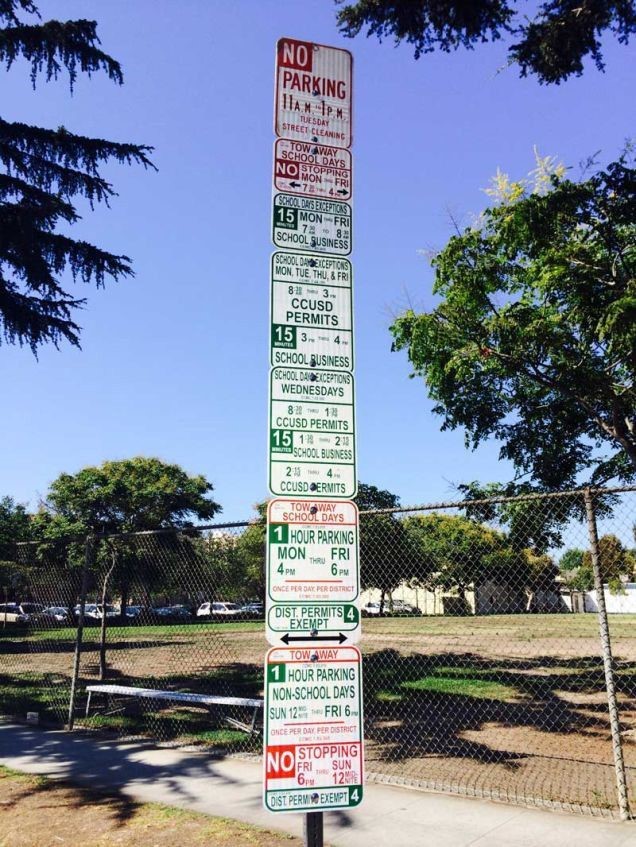Our world of communities and groups of people is highly complex. Interactions are fraught with risks. Our technologies (including automobiles and AI) make it only more so. We need real-time, on-the-spot help to guide us through complex activity safely and productively for just about everything we do these days. Actually, we have no choice. Complexity is here to stay. Read how an altogether new view of rules makes a world of difference.
I confess being highly perturbed by this totem pole of parking signs. You?! Surely, I’m not alone.
Ridiculous, right?! First of all, the collective messaging is impossible. Simply overwhelming. I flatly fail the IQ test.
Second, so many rules are suffocating. My gut reaction is fight or flight. Too many rules is never a good thing.
How About a Digital Sign-Post Brain?
 Putting emotions aside, however, let’s look at this situation objectively. For the sake of argument, let’s say that all these behavioral rules are necessary and coherent.
Putting emotions aside, however, let’s look at this situation objectively. For the sake of argument, let’s say that all these behavioral rules are necessary and coherent.
Actually, it’s not a minor point. Our world of communities and groups of people is highly complex. Interactions are fraught with risks. Our technologies (including automobiles) make it only more so. We need real-time, on-the-spot help to guide us through complex activity safely and productively. I don’t mean just parking; I mean for about everything we do in society these days. Actually, we have no choice. Complexity is here to stay.
So, let’s view this parking totem pole as a potential digital opportunity. Hear me out. Suppose these behavioral rules were automated. Also suppose I could drive right up to these signs and be digitally informed in a split second whether I could park or not, and if so, for how long.
What would be needed for support? The sign pole needs a brain (digital) capable both of perception and of simple cognition:
- The perception part is to recognize the car angling to park and identify its special parking tags, if any.
- The cognition part is to assess the rules based on time of day for that particular car.
The real-time on-the-spot answer for the driver is either ‘yes, parking permitted for x amount of time’, or ‘no, parking not permitted at this time’.
A cost-benefit analysis for implementing a digital sign-pole brain might or might not be favorable. Don’t dismiss the idea too fast. Assuming the municipality is serious about enforcing its rules, remember it currently needs people for enforcement and people are expensive. In any case, even if unfavorable today, the equation could easily change in the future.
Making a case for digital sign-post brains, however, is not my real intent in this article. Consider all the cases in the world other than parking where the economics of real-time rule checks would be favorable. Humans (drivers in this case, and maybe cops too) simply aren’t capable of all this real-time knowledge processing.
Let me say that differently. Yes, humans are probably capable given enough time, but is it a good use of that time? No!
Is It AI?
Now let’s consider enforcement of the parking rules. Suppose you do park there when the digital sign-pole brain says you’re not supposed to. Or time runs out on your allotted time. What should happen?
It’s probably not feasible to eject the car from the spot like a jack-in-the-box. But the sign-pole brain could easily summons a tow truck. And since the sign-pole brain perceived your car’s identity, it could certainly issue a (digital) parking citation.
Could statistical AI be could be used to implement the sign-pole brain? Yes, for the perception part of the solution. Nobody really needs any explanation for those results. But for the cognition part? No! We need symbolic rules for that part because the rules must be explainable (readable) for all parties involved (including the judge if you take your parking case to court). No ChatGPT for this part of the problem please!
Actually, the rules are already expressed symbolically. Not fully on the sign pole, of course. Real estate on signage is very limited. But you can be sure they’re reasonably well-expressed in the municipality’s code (regulations not programming). The rules just need digital expression – and the closer to the original form the better.
Although I talk about giving the sign post a digital brain, I do not in any sense mean trying to mimic human intelligence. For the cognition part, I just need the behavioral rules and related enforcement specifications to be automated. No need to complicate.
Behavioral rules like these parking rules are quite different from the inference and chaining rules traditional to symbolic AI (read ‘expert systems’) in at least two ways.
- Behavioral rules can be violated – just like laws and regulations. Actually, the parking rules are laws or regulations. So, dealing with detecting violations and enforcement are central (not secondary) issues.
- Multiple parties are involved. In this example, the parties include both the driver (or driverless car) and the municipality. Behavioral rules are about directly coordinating interactions between people and communities or organizations.
‘Decision’?
Given the multi-party nature of the behavioral rules, are decisions involved? Of course. The driver must make a decision about whether to park there. The digital sign-post brain must make an assessment (‘decision’ if you like) about whether that car is allowed to park there at that particular time. But those are two different decisions by two different parties, independent actors in the interaction.
Does thinking in terms of ‘decision’ (or decision models) help with analyzing the rules? Let’s consider the question in two distinct parts.
- For the driver of the car? Maybe, if you’re trying to understand the thought processes of the driver. (For the record I’m not, but perhaps you are.) Maybe getting a parking citation or being towed are risks the driver is willing to take that day. Who knows what factors might enter their personal decision?! (If you’re programming a driverless car, I certainly hope those other factors don’t get into your code, however.)
- For the municipality? Honestly, I don’t see how ‘decision’ helps the municipality at all. The situation is simply whether the parker is violating one or more rules. That’s simply a fact, not a decision. And cases like these should be ‘decided’ based only on the facts.
Actually, deciding cases based on just facts is what rule of law basically means. In that regard, I believe AI (both the old AI as in expert systems and the new AI as in GPT) has lost sight of a very fundamental idea in business and government.
For more, refer to Rules: Shaping Behavior and Knowledge, by Ronald G. Ross, 2023, 274 pp, https://www.brsolutions.com/rules-shaping-behavior-and-knowledge-book.html
Author: Ronald G. Ross
 Ron is one of the world's foremost authorities on policy interpretation, rules, concept models, business vocabulary, and data design. He is Co-Founder and Principal of Business Rule Solutions, LLC (BRS). At BRS, he has consulted to many hundreds of companies and government bodies around the globe.
Ron is one of the world's foremost authorities on policy interpretation, rules, concept models, business vocabulary, and data design. He is Co-Founder and Principal of Business Rule Solutions, LLC (BRS). At BRS, he has consulted to many hundreds of companies and government bodies around the globe.
Ron is the author of 12 professional books, including his most recent:
Ron is Chair of Building Business Capabilities (BBC), the official conference of the International Institute of Business Analysis (IIBA®). Ron has keynoted dozens of conferences and given seminars to many thousands of people worldwide. He is currently Executive Editor of BRCommunity.com and its flagship on-line publication, Business Rules Journal.
Ron holds an M.S. in information science from the Illinois Institute of Technology and a B.A. from Rice University.